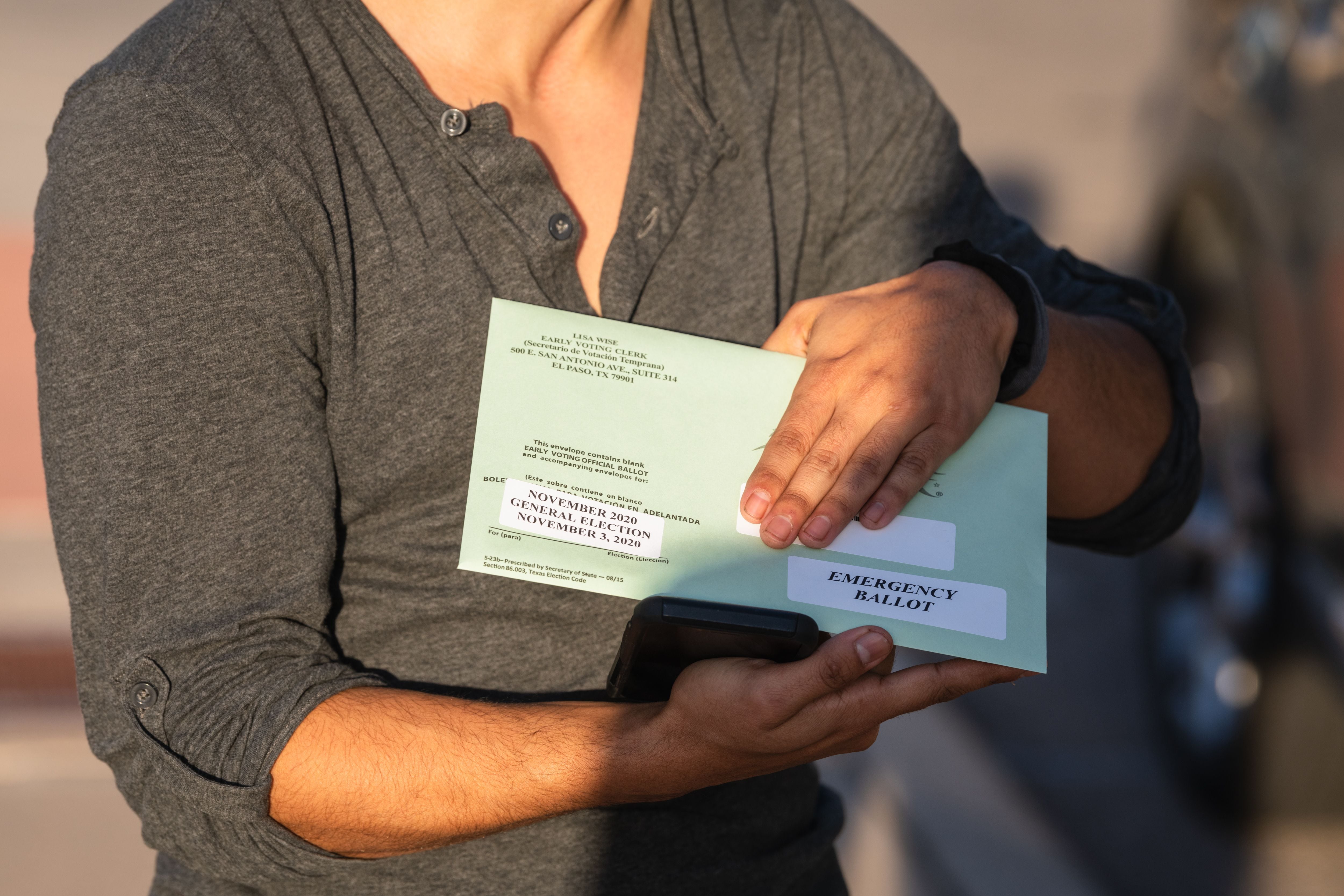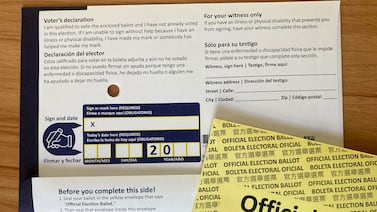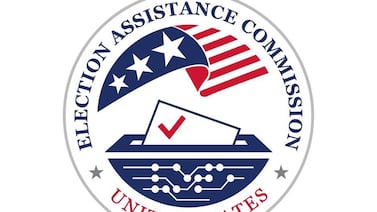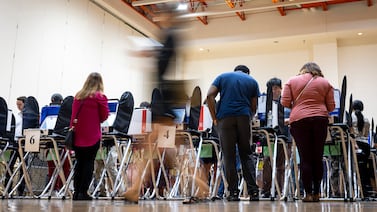Alice Yi of Austin is frustrated when she thinks about the March primary election, when her 92-year-old father tried to vote by mail, as he had many times before, but couldn’t.
He could not remember what identification number he used to register to vote more than 30 years ago, she said. When he sent in his ballot application with the last four digits of his Social Security number, a rejection letter from the elections office said that number was not on file. Another letter later said her father, who is legally blind in one eye, failed to fill out other details, such as specifying which ballot he needed.
By the third attempt, Yi, his caregiver, worried her father’s application would not make it before the deadline and he would be unable to cast a ballot. So she took him to vote in person, for the first time in years.
Yi’s father was just one of thousands of Texans who attempted to vote by mail in the March primary, but collided with the Texas’ GOP restrictive 2021 voting law, known as Senate Bill 1. When voting by mail, the new law requires voters to write their driver’s license, personal identification number, or the last four digits of their Social Security number on their mail ballot application and mail ballot envelope — whichever number they originally used to register.
In fact, the mail-in applications and ballots of Asian, Latino, and Black Texans were rejected because of the new ID requirement at much higher rates than those of white voters, according to a study released Thursday by the Brennan Center for Justice, a nonpartisan law and policy institute. The office of the secretary of state declined to comment on the findings, citing pending litigation over SB 1.
Although researchers couldn’t determine the exact cause of the disparities, experts and advocates say that in addition to the voting law’s restrictions, existing factors rooted in systemic racism, such as lack of resources in their native language and other socioeconomic barriers, likely played a role in the high rejection rates.
In the March primary, 12,000 absentee ballot applications and more than 24,000 mail ballots were rejected, leading to a 12% rejection rate statewide. That represented a significant increase compared to previous years. For example, the rejection rate for the 2020 presidential election was 1%.
The study shows the rejection rate was highest for Asian voters, who were about 40% more likely to have their absentee ballot application rejected than white voters.
The study also shows that Asian and Latino voters were each more than 50% more likely than white voters to have a ballot rejected due to a problem meeting SB 1’s new requirements.
Overall, 19% of Asian voters had either their application or their mail ballot rejected due to SB1’s provisions, followed by 16.6% of Black voters and 16.1% of Latino voters. For white voters, it was 12%.
“This shows that even if you successfully applied to vote by mail, you still weren’t out of the woods, you still might have your ballot rejected,” said Kevin Morris, a researcher with the Brennan Center for Justice and one of the authors of the study. “And not only do we see this gauntlet effect happening, we see that there are big racial discrepancies in whose applications and whose ballots are rejected.”
Morris said two data sets were used to produce the study: the list of Texas’ registered voters and a list of every individual whose application or ballot was rejected, lists both obtained via public records requests. Demographic data about voters’ census tracts and surnames were used to estimate the probability that each voter is a member of different racial groups.
When it comes to the data about ballot applications, the study has caveats: Of the 245 counties included, 89 counties — including 12 counties with populations of more than 50,000 — reported having zero rejected mail ballot applications, even though it’s likely many of those large counties did have rejections. Researchers requested more accurate data from the large counties and received the complete information from three: Travis, El Paso, and Webb Counties.
Excluded from the application rejection data set were Bexar, Bell, Ector, Fort Bend, Hays, Hidalgo, Nueces, Potter, and Waller Counties. The white populations in these counties are smaller than the counties included. “Thus, even if we assume that these disproportionately nonwhite counties did not reject a single application, significant statewide racial discrepancies remain,” the study said.
No counties were missing rejection data for actual ballots, according to the study.
Multilingual resources and community outreach are needed
Alice Yi thinks her father’s experience is instructive. This month he did successfully apply for his mailed ballot, but only because Yi double-checked his application. Otherwise, her father would have again missed including the required ID number on the carrier envelope.
“But what about people who live alone, or in a nursing home or who don’t speak English? How will they know they need to add [an ID number] every time?” said Yi, 65, who for over a decade has been a professional advocate for the Asian community in Texas. “My father is so angry that voting for seniors is so difficult. This makes me so angry and sad. People should be able to vote.”
To help prevent future disenfranchisement of voters of color, Asian American and Pacific Islander, Latino, and Black community advocates say local government officials must prioritize language access and community outreach.
Although mail ballot applications are provided in English and Spanish, only Dallas, Harris, and Tarrant counties provide election materials in a Vietnamese translation. Vietnamese materials were available during the March primary. Harris County also had translations available in Mandarin for the March primary, according to the secretary of state’s office.
Lily Trieu, the interim executive director of Asian Texans for Justice, said the Asian American and Pacific Islander communities in Texas speak more than a dozen languages. The lack of voter-education resources in those languages makes it difficult for AAPI voters to feel confident participating in the process, Trieu said.
“County officials know their communities, they know what languages would be in demand, they have the demographics, they have the data, so they can and they should proactively offer up more resources and additional languages,” Trieu said.
Voters of color also face other socioeconomic barriers to cast a ballot. Lack of transportation and lack of access to the internet are a few examples, said Claudia Yoli Ferla, executive director of the nonprofit MOVE Texas. She said community outreach and voter education is needed beyond the election cycle to ensure voters from underrepresented communities are prepared to vote.
“We’re actively working with our partners in the community to reach out to and to help people who need assistance navigating these restrictive laws, those who have trouble reading, or have other disabilities, need translating services, but who want to vote,” she said. “Making these resources available for people who need it is crucial right now.”
Election administrators try to smooth the way
Absentee ballot rejection rates have been lower in Texas’s smaller elections since the March primary. The mail ballot rejection rate was at 5% for the May 7 Constitutional Amendment election, according to the secretary of state’s office. For the May 24 primary runoff elections, the statewide mail ballot rejection rate across both the Republican and Democratic primaries was 3.9%. Both of those elections, however, drew only a fraction of the voters who cast ballots in the primary.
Efforts made by local election officials across Texas counties contributed to the decrease in rejections.
Trudy Hancock, the Brazos County elections administrator and president of the Texas Association of Elections Administrators, said election officials have proactively included brightly colored paper inserts in mail ballots, reminding voters to include their ID number on the carrier envelope.
Election administrators are also doing public service announcements on local TV stations and talking to local newspapers, reminding voters of the requirements.
Hancock says the efforts have gone a long way in Brazos County. A few hundred of the 2,000 mailed ballots for the general election her office has mailed out so far have been returned, and only five were missing the information, she said — a big improvement.
“We took up a lot of new voters for the midterm election,” she said. “So the few that we’re receiving back and missing the information are those that did not vote in the primary. This is a new process for them. Those who voted in the primary and the runoff know what they need to do, as opposed to someone who is only voting in the November election.”
The secretary of state’s election division this fall launched a statewide voter education campaign dubbed VoteReady that features paid TV, radio, social media advertisements with information in English and Spanish about voter ID requirements in Texas. The elections division also updated the design of the carrier envelope this summer to place a bold red box around the ID field, to ensure voters do not miss that section.
Litigation over these SB1 provisions are still underway and are not set to be heard by the courts until next summer, said Sean Morales-Doyle, the Brennan Center’s voting rights program director. The U.S. Department of Justice challenged the voting law’s constraints on how people voting by mail verify their identities, as well as its limits on assistance to voters with disabilities and those who speak a language other than English. Coalitions of civil rights groups also filed lawsuits challenging the bill.
“But it’s important, heading into the November election, that the public be aware of the very real impact this law is having now,” Morales-Doyle said. “Hopefully the Texas Legislature will take this into account and do the right thing and take this issue seriously in the spring.”
Natalia Contreras is a reporter for Votebeat in partnership with the Texas Tribune. Contact Natalia at ncontreras@votebeat.org








